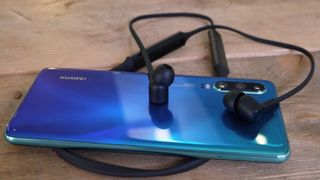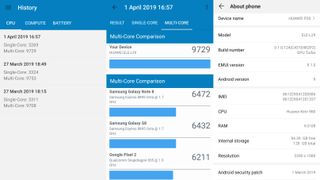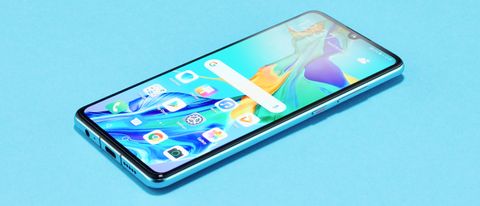Why you can trust TechRadar
Interface and reliability
Huawei runs its own EMUI interface over Android 9 Pie, which isn’t as intuitive as the stock operating system, although you can tweak it to get a little bit closer to standard-issue Android if you prefer.
The default user interface has no app drawer, so when you download an app it’ll be dumped on a home page – in the settings menu you can enable the drawer, but it doesn’t work the same as the one in Android, as you can’t swipe up to access it.
You have to press a button to open it on the home page, which is a little unintuitive, and instead we found ourselves swiping down on the home page to navigate the phone, which brings up recent apps and a search bar to find everything else.

Icons for Huawei’s first-party apps, of which there are loads, are vibrant and bright – so vibrant, in fact, that combined with the colorful default wallpapers the home screen can look more like a child’s art project than a smartphone interface – it’s not necessarily ugly, but it’s very much an acquired taste, and the app icons would definitely seem jarring if you had a subtler wallpaper.
Generally though, the Huawei P30’s user interface runs the same as Android 9, with features like adaptive brightness and a side-mounted volume bar present as expected.
It’s worth noting that both face and fingerprint recognition were a little slow in the Huawei P30. Face recognition would often take a couple of seconds to recognize us, so waking the handset didn’t always feel as smooth a process as it should, although it did recognize us in dark environments and after we’d had a shave, so it’s reliable if nothing else.
The in-screen fingerprint sensor also took a while to recognize our finger compared to other phones, and it was a bit too low in the screen to be intuitive to use.
Movies, music and gaming
The Kirin 980 chipset powering the Huawei P30 is rather powerful, as we’ll get into in the ‘Performance and benchmarks’ section, so the phone can run all kinds of high-end games with minimal lag or other problem.
The wide screen made action games easy to play, as we could use on-screen joysticks without getting our thumbs in the way, and the minimal design of the phone meant we weren’t accidentally pressing side buttons all the time – although the position of the rear camera meant we kept accidentally putting our fingers on the lenses and smudging them.

The screen space was also great for streaming media, with the bright display helping content to look great – the slightly duller colors didn’t matter as much for films and TV shows as for photography, and all in all the screen quality was wonderful.
Music sounded good through the speakers, and the stereo sound was pretty high-quality, but we mostly listened to music on the Huawei FreeLace headphones that Huawei launched alongside the P30 and P30 Pro. These were easy to set up via the USB-C connection, paired with the P30 easily, and provided impressive sound quality.
One problem is that you need to charge the FreeLace buds through the P30 using USB-C (although they come with an adapter so you can charge it with a USB-C charger), which took a chunk of battery off the phone, but we always made it through a full day of using both devices, so it wasn’t a huge concern.

Performance and benchmarks
The Huawei P30 isn’t a phone you’d naturally consider if you need great processing power. Although it has 6GB of RAM and an impressive Kirin 980 chipset, with a chunky battery providing plenty of juice, if you want a handset for power-intensive tasks you’re more likely to to look at something like the iPhone XS or Samsung Galaxy S10.
That said, when we ran a benchmark test on the Huawei P30, it returned a multi-core score of 9,730 – that’s an impressive figure, nearly as good as the iPhone XS and S10, which scored 11,481 and 11,002 respectively, and a huge leap up from the 6,681 score of the Huawei P20.

Such a high score means the phone will run smoothly and be, but where that power is really need is for the camera, as it powers the range of AI and post-processing tasks needed to capture what are, as we’ve mentioned, great-looking shots.
Current page: Anything else I should know?
Prev Page Battery life and camera Next Page Verdict and competition
Tom Bedford was deputy phones editor on TechRadar until late 2022, having worked his way up from staff writer. Though he specialized in phones and tablets, he also took on other tech like electric scooters, smartwatches, fitness, mobile gaming and more. He is based in London, UK and now works for the entertainment site What To Watch.
He graduated in American Literature and Creative Writing from the University of East Anglia. Prior to working on TechRadar, he freelanced in tech, gaming and entertainment, and also spent many years working as a mixologist. He also currently works in film as a screenwriter, director and producer.

